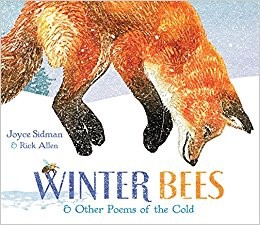JANUARY 2018

Winter Bees & Other Poems of the Cold
by Joyce Sidman, Illustrated by Rick Allen
How do animals brave the longest and coldest season of the north? See the tundra swans settle into sleep. Hear the fee-bee of the chickadee singing from its perch in the evergreen. Watch beavers dive deep beneath the frozen pond, and moose wade through sparkling snow. Discover winter’s safe places for these hardy creatures—how they snuggle warmly and survive until spring’s warmth returns.
A Note from the First Lady
Dear Read20 Book Club families,
Winter can be a magical time! With snow on the ground, icicles hanging from roofs and fires roaring, it can be fun to bundle up and enjoy the warmth inside with family, friends and a mug of hot cocoa. But have you ever thought about what animals do during the cold winter months? How do they survive the freezing temperatures and harsh conditions?
Winter Bees & Other Poems of the Cold introduces a new way of thinking about our furry friends and other elements of nature in a delightfully enjoyable way. You’ll be as intrigued by the lyrical poetry and interesting non-fictional information as you are dazzled by Rick Allen’s illustrations. I hope you discover something new from this book and I hope your whole year is filled with learning new things.
Keep up the great reading!
Crissy Haslam
First Lady of Tennessee
Fun Family Activities
1. Beyond the Book: Winter Bees and Other Poems of the Cold was inspired in a special way by author Joyce Sidman’s experiences of winter in her hometown of Wayzata, Minnesota. The stories and poems came from her attention to detail and curiosity about nature as she enjoyed snowy walks with her dogs. Watch this PBS special to gain some insight into Sidman’s creative process. How does the poet explain what inspired her to write this particular collection of poetry? How does she explain how she actually brainstorms what to write? What did you think about the “Welcome, Winter!” poem that she wrote with the children in the library? How do the words of the poet inspire the illustrator?
2. Research: Can you think of other animals that might need to find a unique way to stay warm in the winter? Pick two animals to research and head to your local library to find books or internet articles on how these creatures survive the winter. What do they use for shelter? How do they keep their bodies warm? How do they find food during the winter? What do they do when it snows?
3. Open to Interpretation: Read and Listen to “Winter Poem” by Knoxville poet, Nikki Giovanni. Try to explain the poem in your own words. What happened to the little girl? Do you think these things really happened? One of the beautiful things about the way poetry is written is that it can be open to interpretation. Giovanni wrote this poem in a style called free verse, which means it doesn’t have to include any rhyming words or rhythm. Try writing your own poem about snow or a wintry landscape! It could be in free verse, like “Winter Poem”, or you could choose haiku, cinquain, couplet or any style you choose.
4. Further Reading: If you enjoyed this book, author Joyce Sidman has written many stories and poetry collections for you to choose from for your next read! Visit your local library to check out her other titles including Round, Song of the Water Boatman, Dark Emperor and Red Sings from Treetops..